Theory of Edge Effects and Conductance for Applications in Graphene-Based Nanoantennas
Abstract
1. Introduction
2. Optical Conductance of a Terminated Graphene Sheet
2.1. Kubo Approach for Optical Conductance of Graphene
2.2. Zigzag Edges
2.3. Approximation for Zero Temperature
2.4. The Limit of an Infinite Sheet
2.5. Optical Conductance for the Edge with Infinite Mass Boundary Condition
3. Numerical Results and Discussion
4. Conclusions and Outlook
- We developed a new theory of interaction of electromagnetic field with a graphene sheet for nanoantenna applications in the THz, infrared, and optical frequency ranges. The main characteristic feature of our theory is accounting for edge effects in a self-consistent manner. It is based on the concept of optical conductance considered as a general susceptibility and calculated by the Kubo approach. The model is based on the concept of Dirac pseudo-spins founded via solving the boundary value problem for the Dirac equation with the appropriate boundary conditions satisfying the physical model, including edge effects of the sheet;
- The main manifestation of the importance of edge effects is demonstrated by the inhomogeneity of the optical conductance. The amplitude and period of its oscillations depend on the length of the sheet and on the electrochemical potential. It is defined by the number of pseudo-spin modes supporting the conductance;
- The developed theory is applied for the simulation of the sheet conductance in a wide range of sample parameters (length 2.1–800 nm and electrochemical potential 0.1–1.0 eV). It is shown that for a length exceeding 800 nm our model and the widely used Drude model of conductivity agree to a high degree of accuracy. However, for small geometric sizes (i.e., smaller than 50 nm), the physical picture of conductivity with respect to the Drude model changes dramatically due to the influence of edge effects. This circumstance should be accounted for in the design of graphene-based resonant THz antennas and other types of photonic and plasmonic nanodevices;
- It is shown that the qualitative distribution of the conductivity along the sheet strongly depends on the electrochemical potential. Thus, it is possible to control the conductivity and performance of graphene nanoantennas, by means of varying the gate voltage.
Author Contributions
Funding
Institutional Review Board Statement
Informed Consent Statement
Data Availability Statement
Conflicts of Interest
Appendix A. Derivation of Equation (16)
Appendix B. Group Velocity of Pseudo-spins in Graphene Sheet
Appendix C. Orthogonality of Pseudo-Spin Modes
References
- Novotny, L.; van Hulst, N.F. Antennas for light. Nat. Photonics 2011, 5, 83–90. [Google Scholar] [CrossRef]
- Giannini, V.; Fernandez-Domínguez, A.I.; Heck, S.C.; Maier, S.A. Plasmonic nanoantennas: Fundamentals and their use in controlling the radiative properties of nanoemitters. Chem. Rev. 2011, 111, 3888–3912. [Google Scholar] [CrossRef] [PubMed]
- Bharadwaj, P.; Deutsch, B.; Novotny, L. Optical antennas. Adv. Opt. Photonics 2009, 1, 438–483. [Google Scholar] [CrossRef]
- Parzefall, M.; Novotny, L. Optical antennas driven by quantum tunneling: A key issues review. Rep. Prog. Phys. 2019, 82, 112401. [Google Scholar] [CrossRef] [PubMed]
- Slepyan, G.Y.; Vlasenko, S.; Mogilevtsev, D. Quantum Antennas. Adv. Quantum Technol. 2020, 3, 1900120. [Google Scholar] [CrossRef]
- Ullah, Z.; Witjaksono, G.; Nawi, I.; Tansu, N.; Khattak, M.I.; Junaid, M. A review on the development of tunable graphene nanoantennas for terahertz optoelectronic and plasmonic applications. Sensors 2020, 20, 1401. [Google Scholar] [CrossRef]
- Baydin, A.; Tay, F.; Fan, J.; Manjappa, M.; Gao, W.; Kono, J. Carbon nanotube devices for quantum technology. Materials 2022, 15, 1535. [Google Scholar] [CrossRef]
- Pistolesi, F.; Cleland, A.N.; Bachtold, A. Proposal for a nanomechanical qubit. Phys. Rev. X 2021, 11, 031027. [Google Scholar] [CrossRef]
- De Volder, M.F.L.; Tawfick, S.H.; Baughman, R.H.; Hart, J.H. Carbon nanotubes: Present and future commercial applications. Science 2013, V, 3391. [Google Scholar] [CrossRef]
- Romagnoli, M.; Sorianello, V.; Midrio, M.; Koppens, F.H.L.; Huyghebaert, C.; Neumaier, D.; Galli, P.; Templ, W.; D’Errico, A.; Ferrari, A.C. Graphene-based integrated photonics for next-generation datacom and telecom. Nat. Rev. Mater. 2018, 3, 392–414. [Google Scholar] [CrossRef]
- Basov, D.N.; Fogler, M.M.; Lanzara, A.; Wang, F.; Zhang, Y. Colloquium: Graphene spectroscopy. Rev. Mod. Phys. 2014, 86, 959. [Google Scholar] [CrossRef]
- Kavitha, S.; Sairam, K.V.S.S.S.S.; Singh, A. Graphene plasmonic nano-antenna for terahertz communication. Appl. Sci. 2022, 4, 114. [Google Scholar] [CrossRef]
- Hofferber, E.M.; Stapleton, J.A.; Iverson, N.M. Single walled carbon nanotubes as optical sensors for biological applications. J. Electrochem. Soc. 2020, 167, 037530. [Google Scholar] [CrossRef]
- Nadeem, S.; Ijaz, S. Single wall carbon nanotube (SWCNT) examination on blood flow through a multiple stenosed artery with variable nanofluid viscosity. AIP Adv. 2015, 5, 107217. [Google Scholar] [CrossRef]
- Margetis, D.; Stauber, T. Theory of plasmonic edge states in chiral bilayer systems. Phys. Rev. B 2021, 104, 115422. [Google Scholar] [CrossRef]
- Yao, W.; Shengyuan, A.Y.; Niu, Q. Edge states in graphene: From gapped flat-band to gapless chiral modes. Phys. Rev. Lett. 2009, 102, 096801. [Google Scholar] [CrossRef]
- Katsnelson, M.I. The Physics of Graphene, 2nd ed.; Cambridge University Press: Cambridge, UK, 2020. [Google Scholar]
- Castro Neto, A.H.; Guinea, F.; Peres, N.M.R.; Novoselov, K.S.; Geim, A.K. The electronic properties of graphene. Rev. Mod. Phys. 2009, 81, 109–135. [Google Scholar] [CrossRef]
- Armitage, N.P.; Mele, E.J.; Vishwanath, V. Weyl and Dirac semimetals in three-dimensional solids. Rev. Mod. Phys. 2018, 90, 015001. [Google Scholar] [CrossRef]
- Qi, X.L.; Zhang, S.C. Topological insulators and superconductors. Rev. Mod. Phys. 2011, 83, 1057. [Google Scholar] [CrossRef]
- Hasan, M.Z.; Kane, C.L. Topological insulators. Rev. Mod. Phys. 2010, 82, 3045. [Google Scholar] [CrossRef]
- Felsen, L.B.; Marcuvitz, N. Radiation and Scattering of Waves; IEEE Press Series on Electromagnetic Waves; Prentice-Hall: Englewood Cliffs, NJ, USA, 1972. [Google Scholar]
- Noble, B. The Wiener-Hopf Technique, 2nd ed.; Chelsea Pub. Co.: New York, NY, USA, 1988. [Google Scholar]
- Miloh, T. Opto-electro-fluidics and tip coax conical surface plasmons. Phys. Rev. Fluids 2016, 1, 044105. [Google Scholar] [CrossRef]
- Meixner, J. The behavior of electromagnetic fields at edges. IEEE Trans. Antennas Propag. 1972, 20, 442–446. [Google Scholar] [CrossRef]
- Akhmerov, A.R.; Beenakker, C.W.J. Boundary conditions for Dirac fermions on a terminated honeycomb lattice. Phys. Rev. B 2008, 77, 085423. [Google Scholar] [CrossRef]
- Balanis, C.A. Antenna Theory-Analysis and Design, 3rd ed.; John Wiley & Sons, Inc.: Hoboken, NJ, USA, 2005. [Google Scholar]
- Agio, M.; Alu, A. Optical Antennas; Cambridge University Press: Cambridge, UK, 2013. [Google Scholar]
- Maffucci, A.; Miano, G. Electrical Properties of Graphene for Interconnect Applications. Appl. Sci. 2014, 4, 305–317. [Google Scholar] [CrossRef]
- Zhao, D.; Wang, L.; Liu, F.; Zhong, D.; Wu, M. Photonic Stopband Filters Based on Graphene-Pair Arrays. Appl. Sci. 2021, 11, 11557. [Google Scholar] [CrossRef]
- Slepyan, G.Y.; Shuba, M.V.; Maksimenko, S.A.; Lakhtakia, A. Theory of optical scattering by achiral carbon nanotubes and their potential as optical nanoantennas. Phys. Rev. B 2006, 73, 195416. [Google Scholar] [CrossRef]
- Shuba, M.V.; Slepyan, G.Y.; Maksimenko, S.A.; Thomsen, C.; Lakhtakia, A. Theory of multiwall carbon nanotubes as waveguides and antennas in the infrared and the visible regimes. Phys. Rev. B 2009, 79, 155403. [Google Scholar] [CrossRef]
- Hanson, G.W. Radiation efficiency of nano-radius dipole antennas in the microwave and far-infrared regimes. IEEE Antennas Propag. Mag. 2008, 50, 66–77. [Google Scholar] [CrossRef]
- Hao, J.; Hanson, G.W. Infrared and Optical Properties of Carbon Nanotube Dipole Antennas. IEEE Trans. Nanotechnol. 2006, 5, 766. [Google Scholar] [CrossRef]
- Slepyan, G.Y.; Maksimenko, S.A.; Lakhtakia, A.; Yevtushenko, V.; Gusakov, V. Electrodynamics of carbon nanotubes: Dynamics conductivity, impedance boundary conditions and surface wave propagation. Phys. Rev. B 1999, 60, 17136–17149. [Google Scholar] [CrossRef]
- Shuba, M.V.; Paddubskaya, A.G.; Plyushch, A.O.; Kuzhir, P.P.; Slepyan, G.Y.; Maksimenko, S.A.; Ksenevich, V.K.; Buka, P.; Seliuta, D.; Kasalynas, I.; et al. Experimental evidence of localized plasmon resonance in composite materials containing single-wall carbon nanotubes. Phys. Rev. B 2012, 85, 165435. [Google Scholar] [CrossRef]
- Slepyan, G.Y.; Shuba, M.V.; Maksimenko, S.A.; Thomsen, C.; Lakhtakia, A. Terahertz conductivity peak in composite materials containing carbon nanotubes: Theory and interpretation of experiment. Phys. Rev. B 2010, 81, 205423. [Google Scholar] [CrossRef]
- Hanson, G.W. Fundamental transmitting properties of carbon nanotube antennas. IEEE Trans. Antennas Propag. 2005, 53, 3426–3435. [Google Scholar] [CrossRef]
- Hanson, G.W. Dyadic Green’s functions and guided surface waves for a surface conductivity model of graphene. J. Appl. Phys. 2008, 103, 064302. [Google Scholar] [CrossRef]
- Falkovsky, L.A. Optical properties of graphene. J. Phys. Conf. Ser. 2008, 129, 012004. [Google Scholar] [CrossRef]
- Falkovsky, L.A.; Varlamov, A.A. Space-time dispersion of graphene conductivity. Eur. Phys. J. B 2007, 56, 281. [Google Scholar] [CrossRef]
- Falkovsky, L.A.; Pershoguba, S.S. Optical Far-Infrared Properties of a Graphene Monolayer and Multilayer. Phys. Rev. B 2007, 76, 153410. [Google Scholar] [CrossRef]
- Falkovsky, L.A. Optical properties of graphene and IV–VI semiconductors. Phys.-Uspekhi 2008, 51, 887. [Google Scholar] [CrossRef]
- Vorobev, A.S.; Bianco, G.V.; Bruno, G.; D’Orazio, A.; O’Faolain, L.; Grande, M. Tuning of Graphene-Based Optical Devices Operating in the Near-Infrared. Appl. Sci. 2021, 11, 8367. [Google Scholar] [CrossRef]
- Gosciniak, J.; Tan, D.T.H. Graphene-based waveguide integrated dielectric-loaded plasmonic electro-absorption modulators. Nanotechnology 2013, 24, 185202. [Google Scholar] [CrossRef]
- Kosik, M.; Müller, M.M.; Słowik, K.; Bryant, G.; Ayuela, A.; Rockstuhl, C.; Pelc, M. Revising quantum optical phenomena in adatoms coupled to graphene nanoantennas. Nanophotonics 2022, 11, 3281–3298. [Google Scholar] [CrossRef]
- Calafel, A.; Cox, J.D.; Radonjić, M.; Saavedra, J.R.M.; García de Abajo, F.J.; Rozema, L.A.; Walther, P. Quantum computing with graphene plasmons. Quantum Inf. 2019, 5, 37. [Google Scholar] [CrossRef]
- Landau, L.D.; Lifshitz, E.M. Statistical Physics (Course of Theoretical Physics); Pergamon: New York, NY, USA, 1980; Volume 5. [Google Scholar]
- Rozzi, T.; Mencarelli, D.; Zampa, G.M.; Pierantoni, L. Dirac-Based Quantum Admittance of 2D Nanomaterials at Radio Frequencies. Appl. Sci. 2022, 12, 12539. [Google Scholar] [CrossRef]
- Pierantoni, L.; Pelagalli, N.; Mencarelli, D.; di Donato, A.; Orlandini, M.; Pagliuca, J.; Rozzi, T. Dirac Equation-Based Formulation for the Quantum Conductivity in 2D-Nanomaterials. Appl. Sci. 2021, 11, 2398. [Google Scholar] [CrossRef]
- Brey, L.; Fertig, H.A. Electronic States of Graphene Nanoribbons Studied with the Dirac Equation. Phys. Rev. B 2006, 73, 235411. [Google Scholar] [CrossRef]
- Abramowitz, M.; Stegan, I.A.; Romer, R.H. Handbook of Mathematical Functions with Formulas, Graphs, and Mathematical Tables; Applied Mathematics Series; National Bureau of Standards: Washington, DC, USA, 1972. [Google Scholar]
- Peres, N.M.R. Colloquium: The transport properties of graphene: An introduction. Rev. Mod. Phys. 2010, 82, 2673. [Google Scholar] [CrossRef]
- Ye, M.; Crozier, K.B. Metasurface with Metallic Nanoantennas and Graphene Nanoslits for Sensing of Protein Monolayers and Sub-Monolayers. Opt. Express 2020, 28, 18479. [Google Scholar] [CrossRef]
- Singh, A.; Andrello, A.; Thawdar, N.; Jornet, J.M. Design and Operation of a Graphene-Based Plasmonic Nano-Antenna Array for Communication in the Terahertz Band. IEEE J. Sel. Areas Commun. 2020, 38, 2104. [Google Scholar] [CrossRef]
- Sarabalis, C.J.; van Laer, V.; Hill, J.T.; Safavi-Naeini, A.H. Optomechanical antennas for on-chip beam-steering. Opt. Express 2018, 26, 22075–22099. [Google Scholar] [CrossRef]
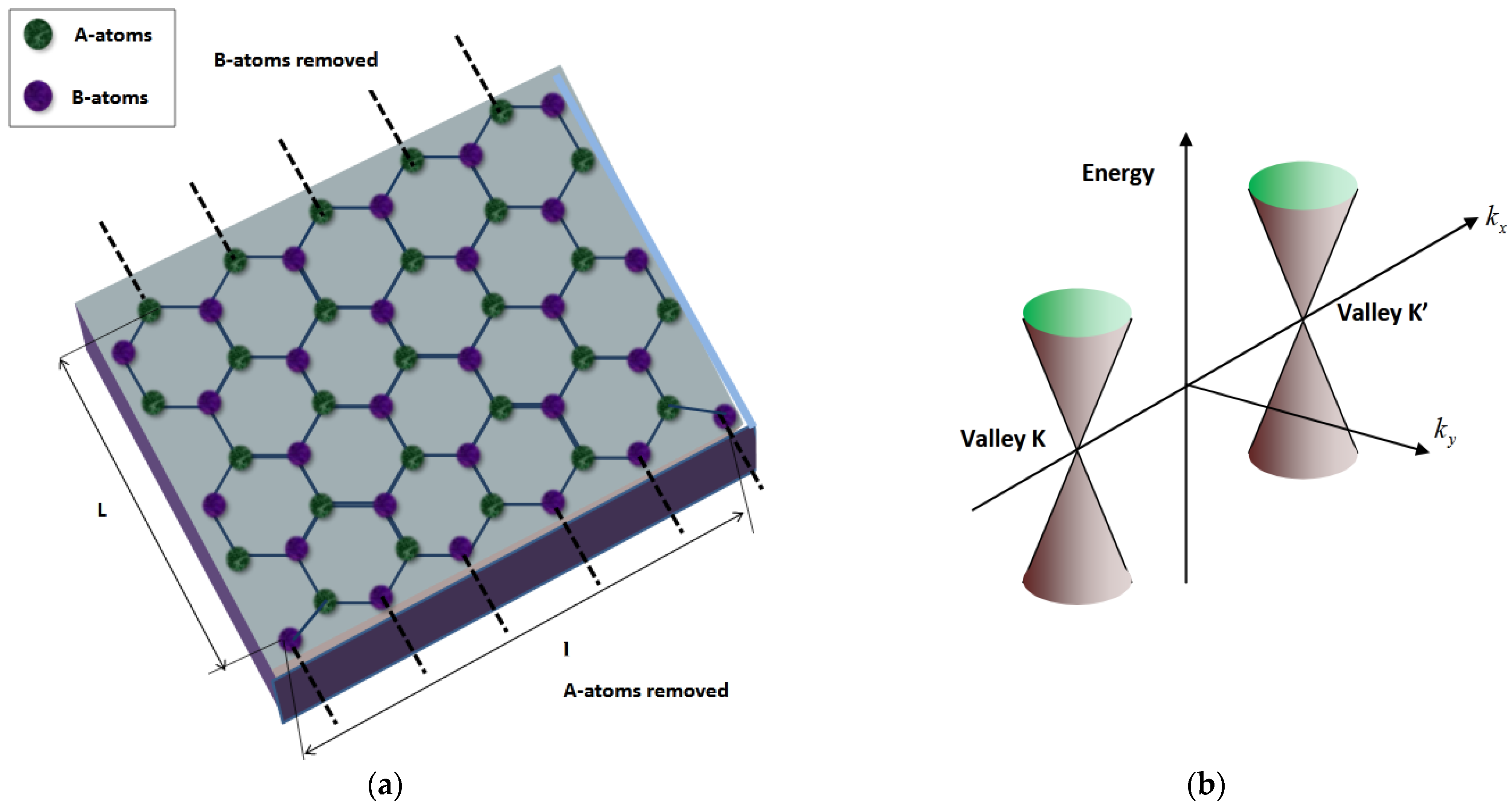
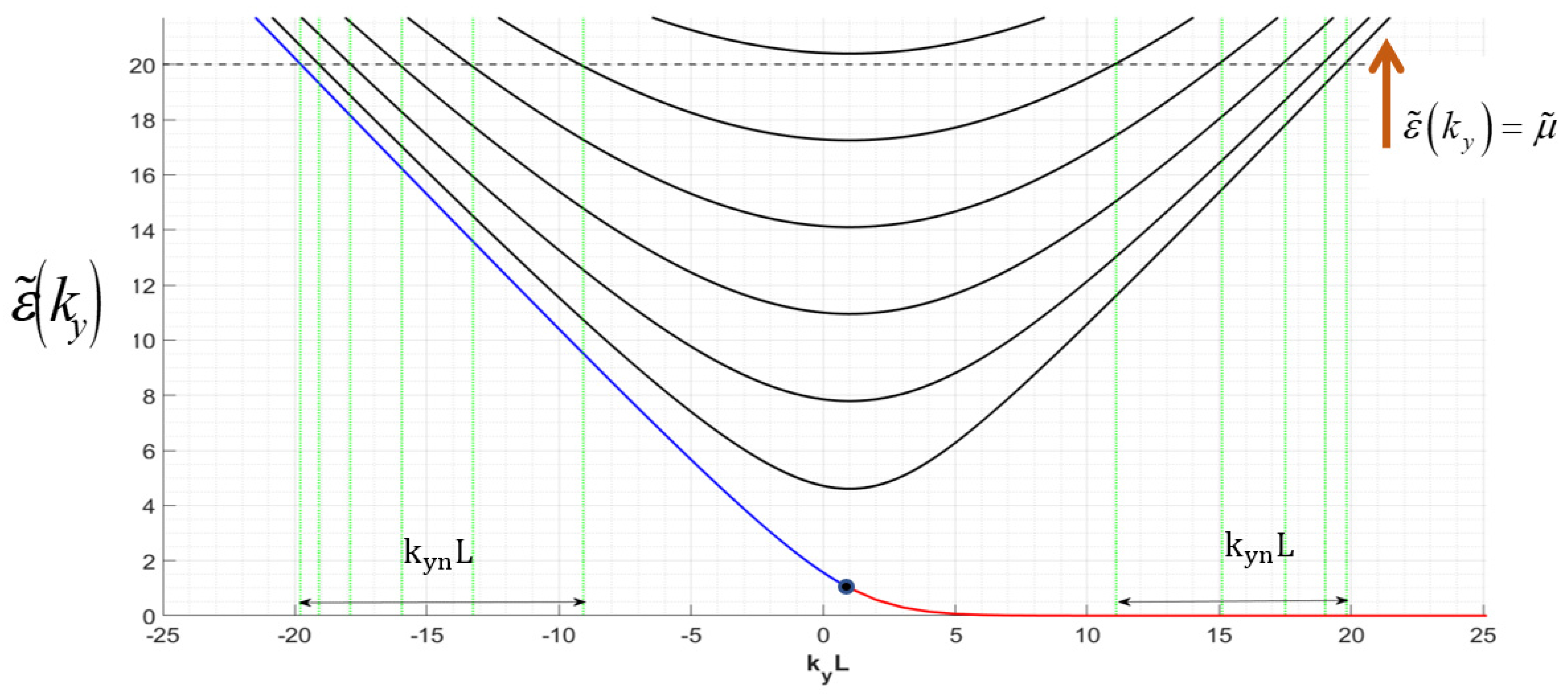
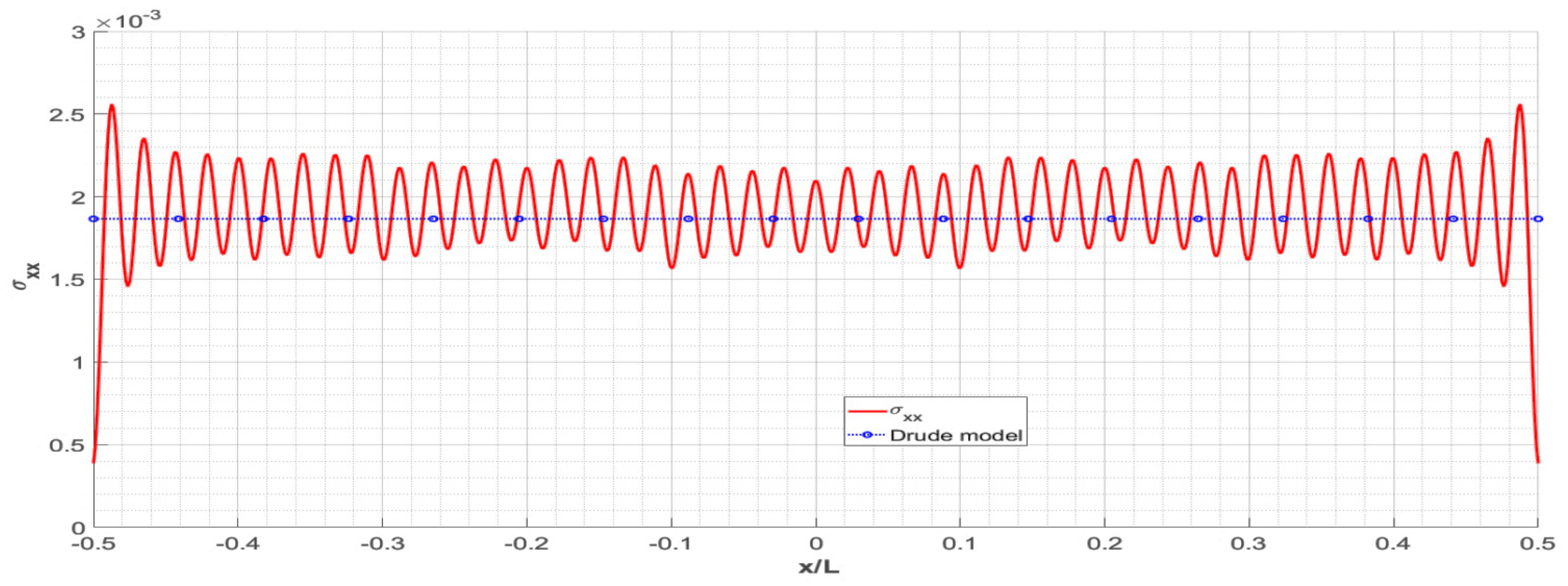



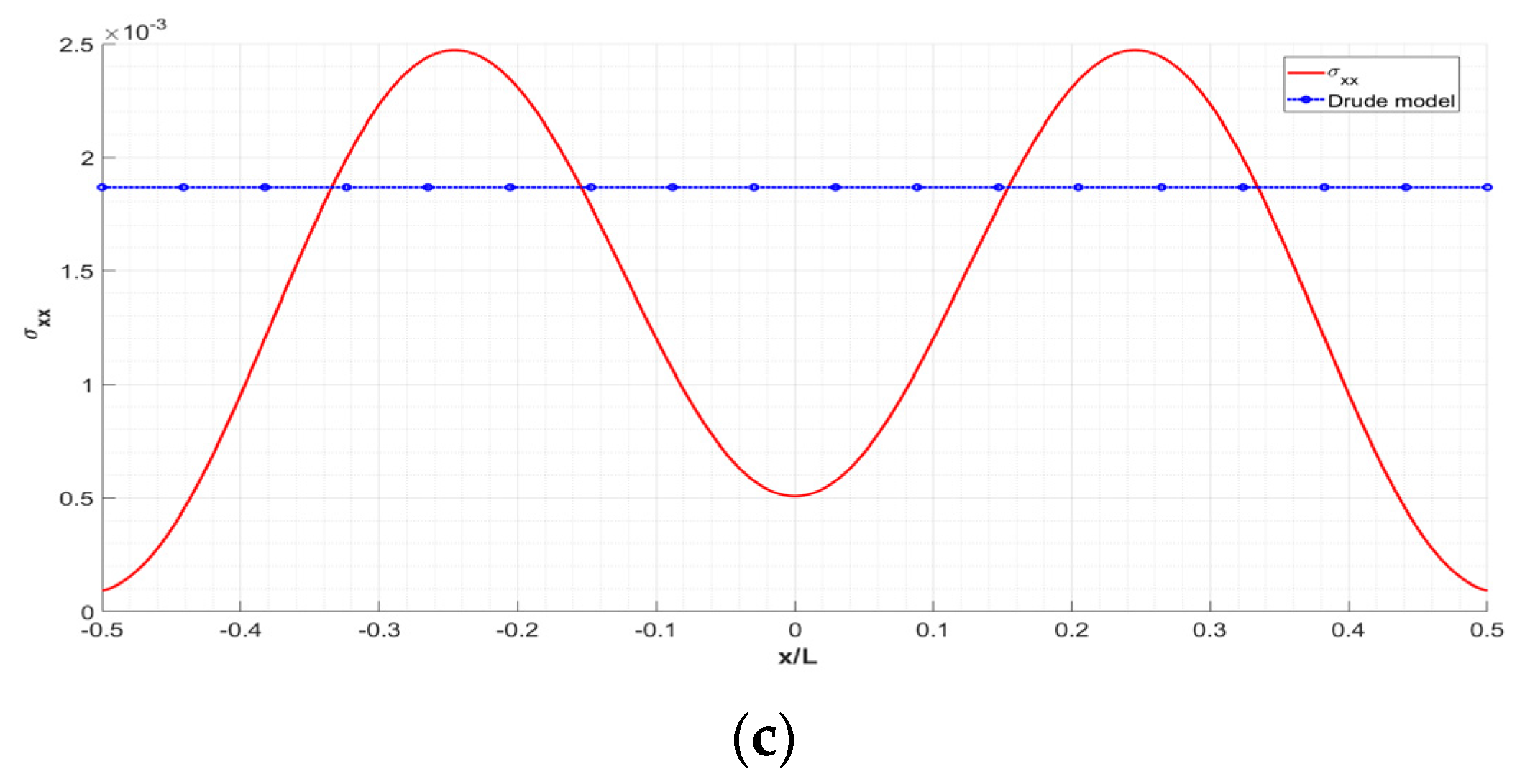
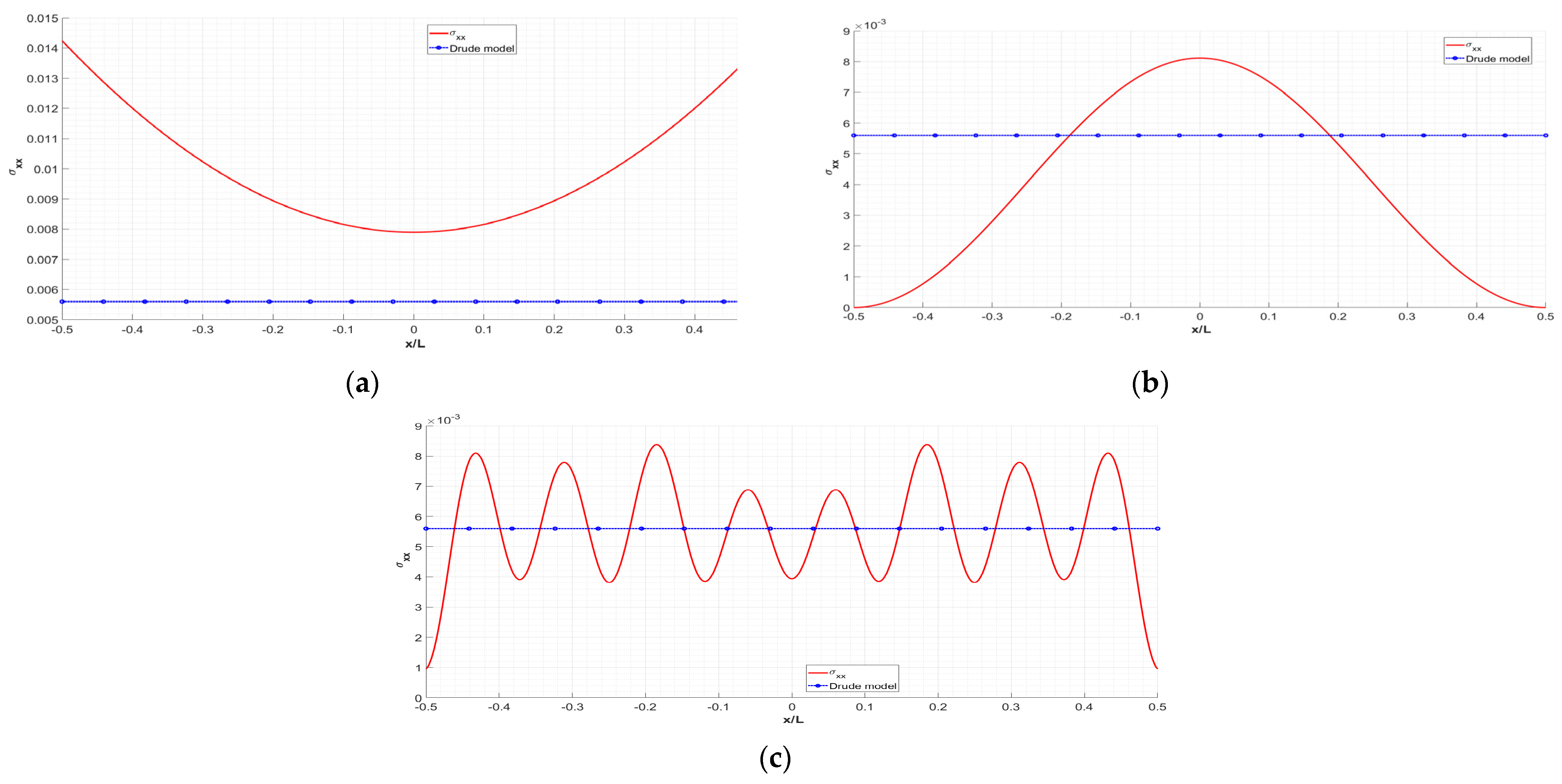

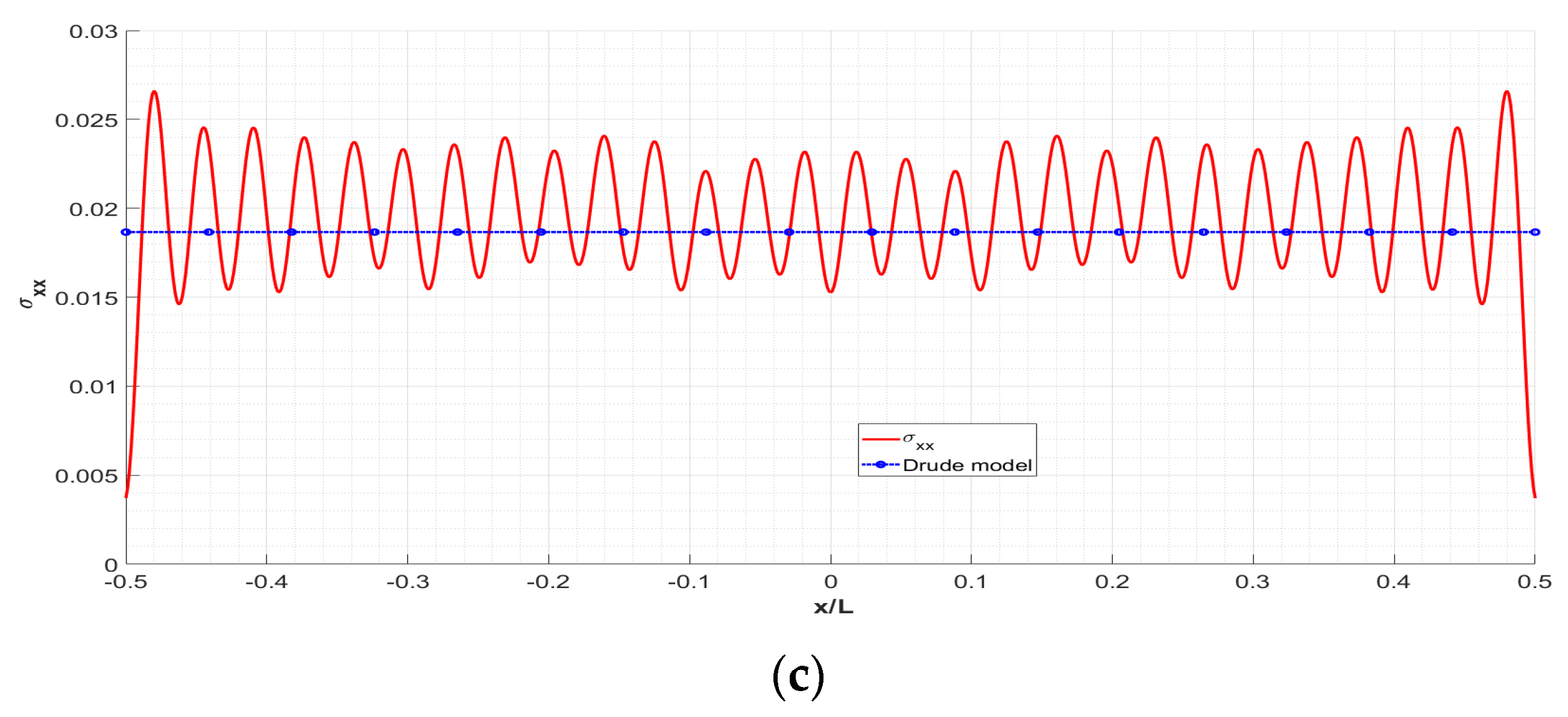
Disclaimer/Publisher’s Note: The statements, opinions and data contained in all publications are solely those of the individual author(s) and contributor(s) and not of MDPI and/or the editor(s). MDPI and/or the editor(s) disclaim responsibility for any injury to people or property resulting from any ideas, methods, instructions or products referred to in the content. |
© 2023 by the authors. Licensee MDPI, Basel, Switzerland. This article is an open access article distributed under the terms and conditions of the Creative Commons Attribution (CC BY) license (https://creativecommons.org/licenses/by/4.0/).
Share and Cite
Berghaus, T.; Miloh, T.; Gottlieb, O.; Slepyan, G.Y. Theory of Edge Effects and Conductance for Applications in Graphene-Based Nanoantennas. Appl. Sci. 2023, 13, 2221. https://doi.org/10.3390/app13042221
Berghaus T, Miloh T, Gottlieb O, Slepyan GY. Theory of Edge Effects and Conductance for Applications in Graphene-Based Nanoantennas. Applied Sciences. 2023; 13(4):2221. https://doi.org/10.3390/app13042221
Chicago/Turabian StyleBerghaus, Tomer, Touvia Miloh, Oded Gottlieb, and Gregory Ya. Slepyan. 2023. "Theory of Edge Effects and Conductance for Applications in Graphene-Based Nanoantennas" Applied Sciences 13, no. 4: 2221. https://doi.org/10.3390/app13042221
APA StyleBerghaus, T., Miloh, T., Gottlieb, O., & Slepyan, G. Y. (2023). Theory of Edge Effects and Conductance for Applications in Graphene-Based Nanoantennas. Applied Sciences, 13(4), 2221. https://doi.org/10.3390/app13042221





